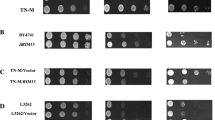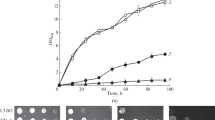Abstract
Objective
To identify a novel gene responsible for organic solvent-tolerance by screening a transposon-mediated deletion mutant library based on Saccharomyces cerevisiae L3262.
Results
One strain tolerant of up to 0.5 % (v/v) n-hexane and cyclohexane was isolated. The determination of transposon insertion site identified one gene, YLR162W, and revealed disruption of the ORF of this gene, indicating that organic solvent tolerance can be conferred. Such a tolerant phenotype reverted to the sensitive phenotype on the autologous or overexpression of this gene. This transposon mutant grew faster than the control strain when cultured at 30 °C in YPD medium containing 0.5 % (v/v) n-hexane and cyclohexane respectively.
Conclusion
Disruption of YLR162W in S. cerevisiae results in increased tolerance to organic solvents.





Similar content being viewed by others
References
Aono R, Doukyu N, Kobayashi H, Nakajima H, Horikoshi K (1994) Oxidative bioconversion of cholesterol by Pseudomonas sp. strain ST-200 in a water–organic solvent two-phase system. Appl Environ Microbiol 60:2518–2523
Burns N, Grimwade B, Ross-Macdonald PB, Choi EY, Finberg K, Roeder GS, Snyder M (1994) Large-scale analysis of gene expression, protein localization, and gene disruption in Saccharomyces cerevisiae. Gene Dev 8:1087–1105
Heipieper HJ, Weber FJ, Sikkema J, Keweloh H, de Bont JAM (1994) Mechanisms of resistance of whole cells to toxic organic solvents. Trends Biotechnol 12:409–415
Isken S, de Bont JAM (1998) Bacteria tolerant to organic solvent. Extremophiles 2:229–238
Kawamoto T, Kanda T, Tanaka A (2001) Preparation of an organic solvent-tolerant strain from Baker’s yeast. Appl Microbiol Biotechnol 55:476–479
Kumar N, Meena RC, Chakrabarti A (2011) Over-expression of YLR162W in Saccharomyces cerevisiae inhibits cell proliferation and renders cells susceptible to the hypoxic conditions induced by cobalt chloride. Indian J Microbiol 51:206–211
Lai LC, Kosorukoff AL, Burke PV, Kwast KE (2006) Metabolic state-dependent remodeling of the transcriptome in response to anoxia and subsequent reoxygenation in Saccharomyces cerevisiae. Eukaryot Cell 5:1468–1489
Livak KJ, Schmittgen TD (2001) Analysis of relative gene expression data using real-time quantitative PCR and the 2(−Delta Delta C(T)) method. Methods 25:402–408
Stephens C, Harrison SJ, Kazan K, Smith FWN, Goulter KC, Maclean DJ, Manners JM (2005) Altered fungal sensitivity to a plant antimicrobial peptide through over-expression of yeast cDNAs. Curr Genet 47:194–201
Wiesenberger G, Steinleitner K, Malli R, Graier WF, Vormann J, Schweyen RJ, Stadler JA (2007) Mg2+ deprivation elicits rapid Ca2+ uptake and activates Ca2+/calceneurin signaling in Saccharomyces cerevisiae. Eukaryot Cell 6:592–599
Yoshikawa K, Tadamasa T, Furusawa C, Nagahisa K, Hirasawa T, Shimizu H (2009) Comprehensive phenotypic analysis for identification of genes affecting growth under ethanol stress in Saccharomyces cerevisiae. FEMS Yeast Res 9:32–44
Acknowledgments
This work was supported by the Jungwon University Research Grant (2015-018).
Supporting information
Supplementary Table 1—Strains, plasmids, and oligonucleotides used in this study.
Author information
Authors and Affiliations
Corresponding author
Electronic supplementary material
Below is the link to the electronic supplementary material.
Rights and permissions
About this article
Cite this article
Kim, HS. Disruption of YLR162W in Saccharomyces cerevisiae results in increased tolerance to organic solvents. Biotechnol Lett 38, 1955–1960 (2016). https://doi.org/10.1007/s10529-016-2188-y
Received:
Accepted:
Published:
Issue Date:
DOI: https://doi.org/10.1007/s10529-016-2188-y




